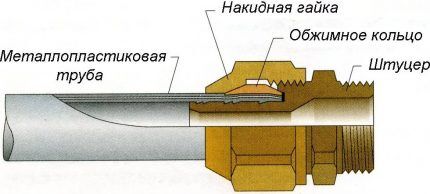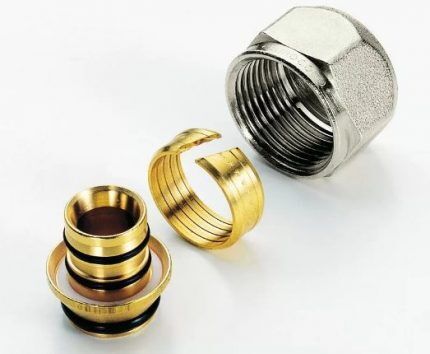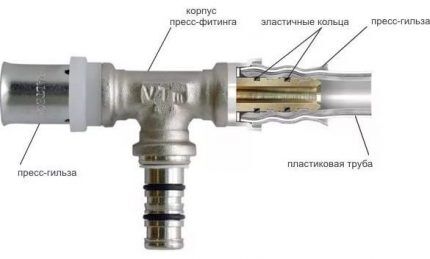Fittings for metal-plastic pipes: types, application, review of the best manufacturers
Due to their performance characteristics, metal-plastic pipes are ideal for creating water supply and heating systems.According to the installation rules, to connect individual fragments it is necessary to use fittings for metal-plastic pipes; other options are not suitable.
The article we presented describes in detail the types of fittings and methods of their installation. Valuable recommendations are given to ensure the correct choice of connectors. Taking into account our advice, you will be able to cope with the assembly and installation of the system yourself.
The content of the article:
Pros and cons of metal-plastic products
Metal-plastic has characteristics that make it possible to create reliable systems with a service life of 15 to 50 years. The outer diameter of the products is 16-63 mm. The fittings must fully match the diameter of the pipes, while the wall thickness (2-3 mm) must also be taken into account.
For internal wiring, the most optimal diameter is 32 mm. Water is supplied to heating devices most often through narrower products - from 22 mm to 24 mm.

Metal-plastic pipelines can withstand temperatures up to +95ºС (with interval increases up to +110ºС), therefore they are used for assembling heating systems. There is a threshold at which pipes freeze - this is -40ºС.Working pressure – 1 kPa. When the temperature decreases, the pressure can increase without the risk of system destruction up to 2.5 kPa.
Advantages of metal-plastic pipelines (when compared with analogues made of metal, PVC and polypropylene):
- Quick installation. To connect individual sections, no welding or soldering is required; keys or a special crimping tool are sufficient.
- There is no need to coat it with protective paint with an anti-corrosion compound.
- Systems with permanent connections are designed for installation in screeds or walls.
- The weight of pipes and fittings is light, which also facilitates installation in various ways.
- During installation, a minimum of waste is generated.
- Protected from stray currents.
- Pipelines with detachable connections are easy to repair and replace fittings.
- They have the ability to connect additional devices without disassembling the entire system.
- Using special fittings they are combined with metal pipes.
There are also disadvantages, and they must be taken into account when installing the wiring yourself. The cost of MP pipes is quite high, and accordingly, fittings are more expensive. Compare Features metal-plastic and polypropylene pipes you can by reading our recommended article.
If the temperature of the liquid in the heating pipeline is constantly maintained at the maximum (+95ºС), the service life of the pipeline is reduced by half. The polymer layer is destroyed by sunlight, therefore, the pipes should not be in the area exposed to ultraviolet radiation.
Types of fittings for metal-plastic
For water pipe laying or heating wiring Various fittings required.The good thing is that now you can buy connecting elements of any configuration in the store and you don’t need to invent anything yourself. Typically, fittings are purchased together with pipes so that the diameter matches. Let's look at what fittings may come in handy.
Classification of fittings by purpose
Its shape (straight, angular, cross-shaped) depends on the purpose of the part. Let's look at the main types using the example of VALTEC products, which are often preferred to other brands due to their good price/quality ratio:
In addition to the listed elements, plugs, fittings, adapters for pipes of other diameters, and water sockets are used.
To find out exactly what fittings are required to assemble communications, you need to draw up a general diagram and count the number of connections, corners, intersections, etc.

Classification by connection method
You can often find a classification in which fittings for metal-plastic pipes are divided into three groups: threaded, compression, press fittings. This is an incorrect division, since the threaded type presupposes the presence of factory or self-made internal or external threads on the pipe and fitting.
Metal-plastic pipes, unlike metal ones, are not cut at the ends before crimping, so it is correct to consider two categories of fittings:
- compression (collet, crimp);
- press fittings.
The type of part is selected depending on the installation scheme and the need for monolithic or prefabricated wiring.
Option #1 - compression fittings
The crimp connection is used quite often, especially in open sections of the pipeline. The crimping process is as follows.
When tightening the union nut (put on the pipe from the outside), the split ring (collet) presses on the outer surface of the pipe, as a result of which the inner surface of the pipe is pressed tightly against the fitting. As a result, a conditionally detachable connection is formed, which is strong, but requires tightening from time to time.

It is worth knowing that there are two types of compression fittings:
- With integrated fitting. The fitting and the body are an indivisible part. When crimping, the fitting is inserted inside the pipe, the body remains outside. The body is usually made of brass, sometimes nickel plated.
- With thread adapter. Differs in the plug-in type of fitting.It has a specific purpose - they act as terminal connectors when installing radiators, manifolds, and pipe fittings.
The dimensions of the adapters depend on the diameter and thickness of the machined pipe. Adapters also differ in the size and shape of the ferrule nut, and the shape of the seal (flat or conical).

No special tool is needed for crimping. Usually open-end or adjustable wrenches are used.
Option #2 – press fittings
Connecting elements of the second type differ from compression analogues in design and crimping results.

Brass is recognized as the ideal body material, but some manufacturers also use bronze. Both materials perform well without additional coating, but tin-plated and nickel-plated parts are also very popular. Along with brass, PPSU and PVDF polymers are used - cheaper, more durable and not subject to corrosion.
The best material for the press sleeve is AISI 304 stainless steel. It is stronger and more stable than aluminum, which is used much less frequently. Some liners have inspection holes necessary to control crimping.
O-rings (gaskets) are made of EPDM or NBR. Options with two seals are more common than with one.
Plastic thrust rings are located between the sleeve and the body. They protect metal parts from electrical damage. Some manufacturers paint the plastic in different colors to make it easier to determine the diameter. Sometimes the rings are equipped with a small protrusion for precise installation of the crimping tool.
According to the rules installation of press fittings This is done using a special tool – press jaws. Hobbyists usually use manual modification; professionals find it more convenient to work with hydraulic and electromechanical devices that simplify the crimping process.

O-rings on fittings from different manufacturers are located in different places. During the crimping process, the tool presses the sleeve as tightly as possible, and the location of the rings plays a crucial role.
For this reason, it is strongly recommended to use press fittings and crimping tools from the same manufacturer, otherwise the connection technology will be disrupted. The exception is the products of companies that prudently produce universal systems.
Compression fitting installation technology
When the necessary tool is at hand, the crimping process compression fitting happens quickly and easily. After two dozen procedures, the hand becomes full, and every movement is brought to automaticity. Perhaps for this reason, pipelines assembled by professional plumbers last about 7 years even without additional twisting (although it is recommended).
So, to install a compression fitting on a metal-plastic pipe you will need scissors (pipe cutter), a calibrator, and open-end wrenches to size. Manually straighten the piece of pipe to be crimped and follow the following instructions:
As a result of crimping, the union nut should not “walk” along the pipe, even if you try to move it by hand.
A few professional tips will help you avoid mistakes when installing a compression fitting:
- Before installing the fitting into the pipe, be sure to check the presence of o-rings: they must be in the grooves intended for them. To prevent the rings from moving out of place during installation, some craftsmen lubricate the fitting with soapy water.
- If the fitting does not fit into the pipe, and the sealing rings are pulled off during installation, it is necessary to perform flaring with a calibrator. If you don't have a special tool at hand, use the end of a wrench.
- When tightening the union nut, control the effort: excessive effort can lead to damage to the edges and deformation of parts of the fitting.
- During installation, two keys are used: with one we hold the fitting, with the other we tighten the nut. It is better to select the sizes in advance, as they are most often non-standard. If you don't have the right size, an adjustable wrench will help.
A properly installed compression fitting will maintain system pressure even when the compressor or pump is running. Approximately once a year it is necessary to carry out an inspection, and if digging is detected, it is recommended to tighten the nuts.
Press fitting installation technology
Press fittings differ in design and, accordingly, installation method. Before installing the connector, you need to carefully inspect the connectors for metal-plastic pipes (sleeve, seals) and prepare the press jaws, suitable in profile and size (ideally from the same manufacturer).
We prepare the pipe in the same way as for a compression fitting - straighten, mark, carefully cut pipe cutter, designed for working with metal-plastic. It is important to process the end part: remove burrs, make the rim smooth and even. We install the fitting in the following order:
When working with hand tools, you need to remember one subtlety of crimping: it must be done twice. That is, after the first clamp, it is necessary to loosen the fixation, rotate the pliers along the axis by approximately 30º and repeat the procedure.
With tips and valuable recommendations for implementation crimping of metal-plastic pipes you will find out by reading the article we recommend.
What do you need to know about the difference in methods?
Before choosing the type of fittings installed on a water supply or heating system, you need to become familiar with the differences between two different crimping methods:
- A pipeline with compression fittings is serviceable (needs tightening the nuts approximately once a year), and a system with press fittings is monolithic and maintenance-free.
- To install compression parts, available tools are sufficient; to install the press sleeve, special press pliers are required.
- A system with compression fittings can be disassembled at any time to replace parts or repairs; if a pipeline with press fittings has to be changed, it must be completely replaced.
- The collapsible system must be visible (for regular maintenance); monolithic joints can be filled with screed and hidden in the walls.
If the cost of a set of connecting elements is important, then keep in mind that press fittings are approximately 1.5 times cheaper than their crimp counterparts.
Review of the best manufacturers
Fitting companies usually produce both types, so let's look at four popular brands:
In addition to the listed brands, on the market of fittings for metal-plastic pipelines you can find high-quality products from COMAP (France), ALTSTREAM (Russia), Henco (Belgium), UPONOR (Finland).
Conclusions and useful video on the topic
How to distinguish a compression fitting from an element with a press sleeve and what should be taken into account during the crimping process, you will learn from the following videos.
Video #1: The process of installing a press fitting on a pipeline:

Video #2: Detailed and accessible information about the design and installation of press fittings:

Video #3: Practical tips for working with compression fittings:

One of the advantages of metal-plastic pipelines is ease of assembly using special parts. Crimp and press fittings differ in the method of installation and the need for maintenance, but both types allow you to create functional, reliable water supply and heating systems that last for decades.
If you follow the installation rules, you can independently, without the help of professional plumbers, cope with the installation of intra-house communications.
Please write comments in the block below. Share information with site visitors that will help you correctly assemble and connect sections of the metal-plastic pipeline. Ask questions, post photos related to the topic of the article.




I loved working with metal-plastic, but sometimes such surprises come out that I take my head in my hands. Few people risk embedding even compression fittings into a wall or screed, because over time they have the ability to become loose for various reasons - expansion of the material, water hammer, etc.
Even expensive and branded ones are not immune from this. I had such an incident in a bathroom with hot water. The pipe stood for 8 years, and a small leak began at the fitting.
We had to do destruction, hollow out the tiles, and in a groove, in a limited space, re-dress and press the fitting with pliers - this is not an easy task.
I was tormented, I still remember this hassle.